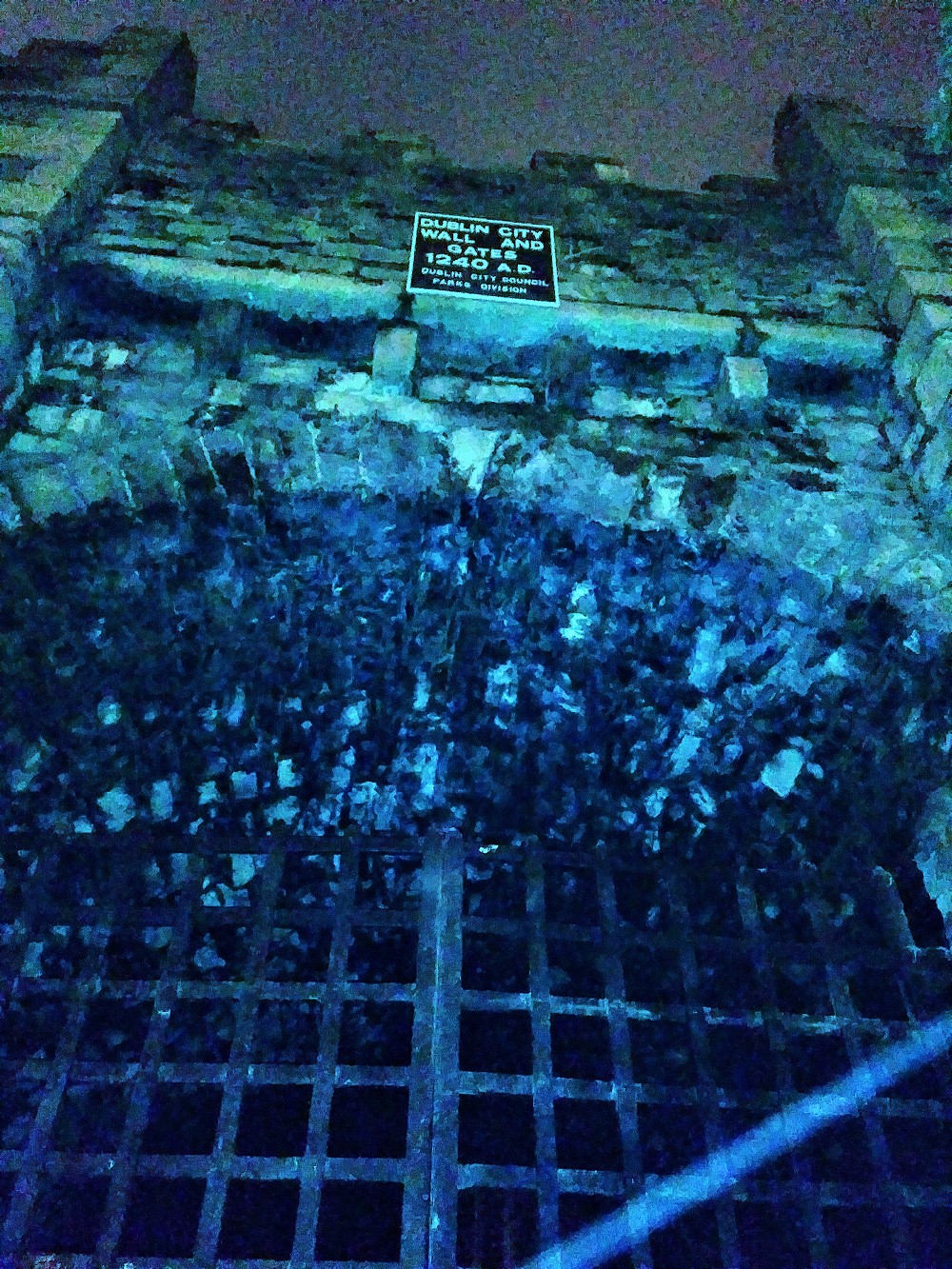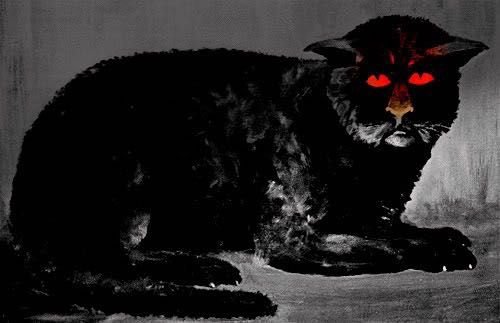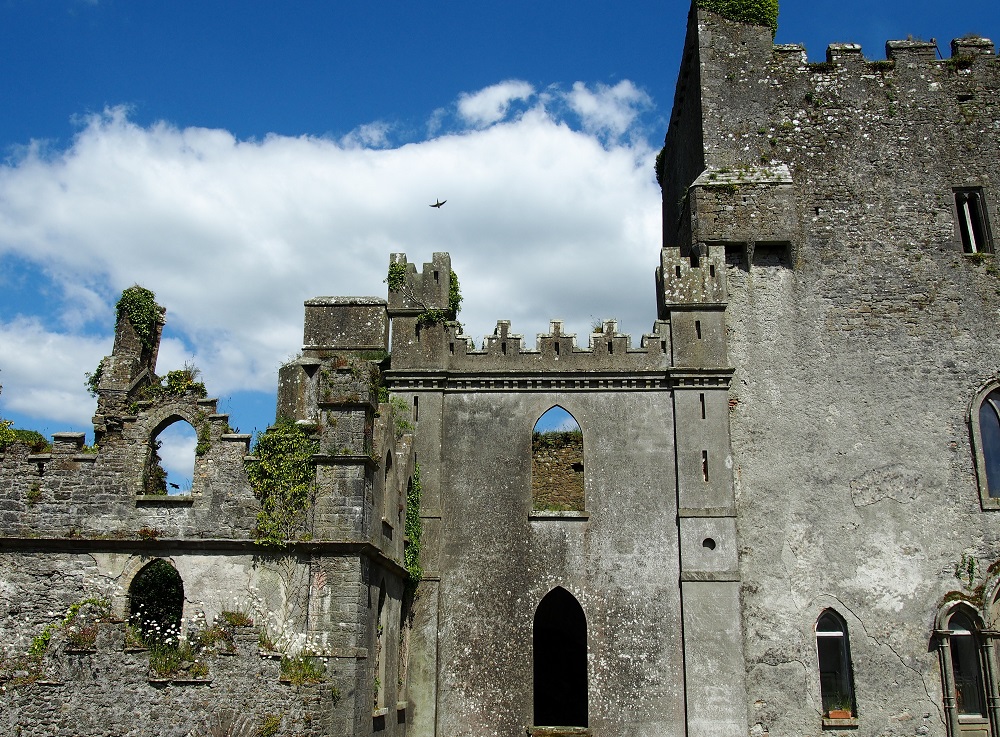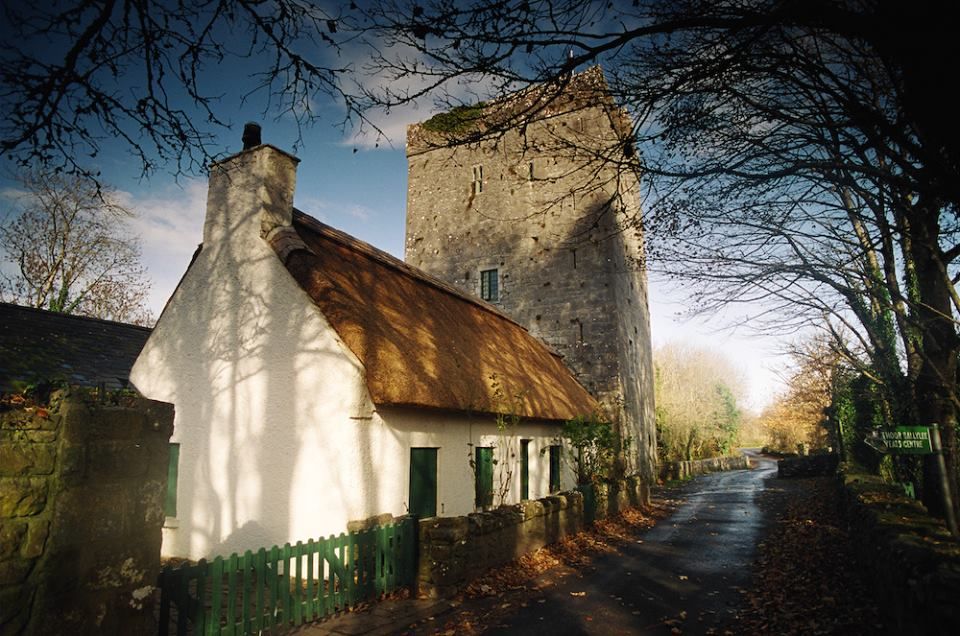They took her lightly back between the night and morrow, they thought she was fast asleep, but she was dead with sorrow ...
Blood and The Moon by W.B. Yeats (1928)
The purity of the unclouded moon

Nuair a shroicheann tú ósta an bháis tá súil agam go bhfuil sé in am dúnta. (When you reach the inn of death, I hope it's closing time.)
Ireland: Where It Always Reigns Mysticism
She haunts all your senses, fair Éire does. From the beauteous and serene, to the horrid and terrorized, and every sensation in between, Ireland shakes you awake, grabs you and presses your soul up to the glass. If you wish for music, food, the written word, drink and dance, there are few better places on the planet to spend a month of moons. Of course, if you jones for more, for a fright on a spooky, drizzly night, Ireland awaits to entrance you all the further. What better time to explore the Haunted Isle than in March, Irish-American Heritage Month?
From the treacherous, seaside cliffs of Northern Irealnd to the fauna sanctuary peninsulas of the Southwest, from contempo County Dublin in the East to romantic County Galway in the West, there are whispers and screams, midnight histories, and tales so horrific they can only be told when daylight streams. Unsettled souls, the murdered, the wronged and the sorely unfortunate, under the cloak of shadow and night drag bodies and bones, claws and foul smells over stone floors, through rotting ruins, up the richest walls of the finest rooms and at the midnight foot of the weary traveller's bed. Listen closely and follow the shrieks for a St. Patrick's Day you might never forget ... for you may be doomed to relive it, for all eternity.
Remember, should you hear the Banshee's cry times three, someone you know could cease to be; should you see her, hard at work, scrubbing the blood from a silken gown or armoured breast-plate, make haste for the nearest chapel, my dear readers, for she could be your final fate.
Ireland boasts a history so richly woven with mysticism, magick and spiritualism, it is very likely if your mind organically channels the spirits, you will find them anywhere you look: from the historic pubs of Dingle to the H&M and Boots in downtown Dublin. However, if you're on the hunt and need a little guidance, JennyPop's list of Éire's more notorious haunts might be a useful guide through the nights. Good luck, travellers and readers alike. Sláinte!
Dunluce Castle, Co. Antrim, Northern Ireland

JennyPop's Five Fave Irish Haunts
Dunluce Castle
87 Dunluce Road, Bushmills, County Antrim, Northern Ireland BT57 8UY
Sea-sprayed and lichen-coated, the seaside ruins of this 14thC., round-tower fortress rest dauntingly atop the Antrim Coast cliffs. Dunluce claims as residents, a winsome White Lady, ghostly tower dwellers and mischievous spirits who, reportedly, play in the gift shop overnight, rearranging books and turning on radios for the morning staff's arrival.
The White Lady hails from Dunluce's origins, the foundations and two round towers built by the MacQuillan sept in the 1300s. A daughter of the family, the now-known White Lady was forbidden by her father to marry the man she loved. As sad, beautiful, medieval nobles were wont to do, she died of a broken heart soon thereafter. Now, she roams the stones, forever young, beauteous and melancholy: the very best look for sporting a long, flowing, white gown as one aimlessly roams castle ruins, atop a jagged cliff overlooking a stormy sea, in an Irish mist, for all eternity.
By the 16thC., inter-family usurpations, kidnap and murder plagued the MacDonnell sept, notably Sorely Boy MacDonnell. After his inheritance of the estate in 1556, his brother-in-law Shane O'Neill captured and imprisoned Sorely Boy during the Battle of Glentaisle. Only after Sorely Boy's posse retaliated and murdered O'Neill during a festive banquet, was Sorely Boy installed again as the rightful occupant and heir to Dunluce.
In 1584, Queen Elizabeth I's Lord Deputy of Ireland, Sir John Perrot, attacked Dunluce sans provocation and garrisoned an army there. Once more, Sorely Boy was ousted from the premises and, in his place, Perrot positioned Peter Carey as castle constable. Queen Elizabeth, however, seems to have known nothing of the attack and, upon learning of it, granted Dunluce back to Sorely Boy. Resurrected, again, Sorely Boy celebrated at Dunluce with a lively banquet and a hanging, of Peter Carey.
As the 17thC. dawned, Dunluce had earned a reputation for desolation and doom. In 1635, Sorely Boy's grandson, Randall MacDonnell, brought his new bride, Catherine Manners, to the castle. Catherine was a widow of the Duke of Buckingham and a dyed-in-the-silk Lady of London. From the moment she stepped onto the Western Isle, Catherine loathed the countryside. The farther north she travelled the deeper her loathing burrowed. The isolation, the placid landscapes and the quiet life set in a madness for the city girl. Most of all, Catherine claimed "the constant boom of the sea drove her to distraction".
On an exceptionally stormy night in 1639, as the family sat to yet another boring dinner in the banquet hall, the north wall of Dunluce's kitchen court crumbled suddenly into the sea, far below. Several of the kitchen staff fell to their terrifying, rocky, briny deaths. From that night, understandably so, Catherine refused "to live on that rock" ever again. As her husband commissioned a new home to be built on the mainland, Dunluce saw fewer inhabitants, less activity, sliding maintenance schedules and, as the years passed, slowly became the spooky, salty ruin it is today.
Most notably, Dunluce Castle features in the origins of the fictitious O'Connor family, as it relates to Miss Erin Tara O'Connor, a prominent, supporting character in author Jennifer Susannah Devore's Savannah of Williamsburg: The Trials of Blackbeard and His Pirates, Virginia 1718 (Book II in the Savannah of Williamsburg Series of Books)
*Dunluce Castle is open for admission and self-guided strolls. For updates, visit their website or phone directly at +44 (0) 28 2073 1938
Carrickfergus Castle, Co. Antrim, Northern Ireland

Carrickfergus Castle
The house that self-fulfilling prophecy built: In the 12thC., Anglo-Normans roamed the Ulster countryside, oot 'n' aboot, looking for land they fancied. When they found just the right bit, they took it. In 1185, a Norman Lord, John deCourcy, heard a prophecy that "a white knight from a foreign land, riding a white horse, with birds of prey upon his shield" would, one day, conquer all of Ulster. "Hey!" deCourcy he thought to himself, "I'm a blond knight from France and could totally get a white horse and make a shield with birds on it!" Because audiences were way easier to convince back then, he assembled an army and led a twenty-five year conquest over Ulster. On every chunk of land he conquered, he built a castle. Carrickfergus is one of those monuments to victory and unfathomable confidence. (I am very well-acquainted with this frame-of-mind; I coud totally see this happening and being toted about the Ulster countryside until he found just the right plot of land. I might have maried into the deCourcy line.)
Today, Carrickfergus is one of the oldest, in-tact, stone castles in Ireland. However, deCourcy's conquest was short-lived. In 1210, England's King John claimed it for himself and it served as a government building for nearly 800 years.
During that time, in the 18thC., consistent military installation oversaw centuries of not only bloodshed but heartache. In 1760, a case worthy of Project Innocence played out at the castle. Infuriated by a duplicitous fiancée, one Betsey Baird, a Carrickfergus soldier known as Robert Rainey rooted out Betsey's illicit paramour, one Col. Jennings and ran him through with his sword. Undaunted and self-satisfied, Rainey returned to his barracks, wiped clean his sword of Jennings' blood, changed shirts and went about his day. Unfortunately, also stationed at Carrickfergus was a soldier named Timothy Lavery. Lavery was a fine fellow who went by the nickname of Buttoncap, for the large, non-issue button he'd attached to his cap. Liked by all, Lavery really had only one fault: he bore a striking resemblance to Rainey. As Jennings lay on his death bed, dying from his sword-wound, he mistakenly identified Lavery, instead of Rainey, as his assailant. Lavery was arrested and sent to the gallows. Claiming innocence to the end, as the noose was pulled over his head and tightened around his neck, he vowed revenge and to haunt the castle forevermore. Today, his sad, vengeful spirit is seen on occasion at a castle well he was known to frequent. It is called Buttoncap's Well.
*Carrickfergus Castle is open for admission and self-guided strolls. Call or visit site updates. Phone: +44 (0) 28 9335 1273.
The Killakee Cat of Killakee House

Killakee House (a.k.a. Dower House)
Below Hell-Fire Club ruins on Montpelier Hill, 12 Killakee Rd. Rathfarnham, Co. Dublin, Dublin D16FT51
Ask Stephen King: some pets are just scary, no matter how much you try to love them. If you've ever had a cat that stalked you, and not playfully, Killakee House Restaurant may not be the dining experience you wish to book. Though the main house - a large, gracious, Regency-era, country home built in 1806 by prominent bookseller Luke White - fell into ill-repair over the last two-hundred years, what does remain today is The Steward's House (a.k.a. Dower House), built circa 1750 -1770. Since the early-2000s, it has stood as a casual dining establishment in the dark and moody hills of County Dublin, overlooking the bustling hub of Dublin Town.
Dower House has been long-reported as haunted. Just above it, up Montpelier Hill lie the wicked ruins of Richard Parsons' Hell-Fire Club. In the 1700s, Satanic and myriad evil events occurred at not only the Hell-Fire, but also inside Dower House. The vile deeds are believed to have included, but are certainly not limited to, devil worship, animal sacrifice and torture (primarily black cats, dousing one poor creature with whisky and settling him ablaze), witch burning, prostitute murders and the deathly beating of a dwarf, as amusement. Evidence of this final "amusement" is the long-forgotten skeleton of a badly deformed dwarf which was found by Dower House renovation workers, in the bell tower, in 1970.
Reported hauntings include sightings of, at least, two ghostly nuns, the spirits of two murdered men, extreme Poltergeist activity, black clouds moving about indoors and various, unsettling, unexplained noises. However, Killakee is best-known for The Killakee Cat. In 1968, Margaret and Nicholas O'Brien purchased the dilapidated Dower House with the intention of refurbishing it into a grand, Fine Arts center and intellectual retreat for writers, dancers and artists of all sorts. In paranormal terms, words like "construction", "renovation" and "refurbishment" are synonymous with "stirring up trouble". As Dower House underwent renovations, it seems trouble was indeed stirred.
Work crews reported, in addition to "general Poltergeist activity", seeing a large, black cat in the gardens. Later that year, Dublin artist and interior decorator Tom McAassey, claimed to see a black cat, "large as a Dalmatian dog" outside the front door.
According to McAssey's personal account in Frank Smyth's Ghosts and Poltergeists, after closing up for the night, one of two workmen on-site with him noted aloud that the heavy, front door was open, even after having locked it. Noticing a dark figure outside the door, McAssey thought it the other workman: the two of them pranking him. He told the figure, thinking it the second workman, "It won’t work, I can see you, so get in". McAssey claimed he then heard a "low voice" reply, "You cannot see me, leave the door open". McAssey turned aroud to see the two workmen standing behind him, well away from the door. In a flash, the two workmen fled the scene in a great fright. Not one to turn tail, McAssey investigated what must be clearly another worker or neighbourhood teen playing a joke. He walked toward the door and, there, now sitting in the foyer, was a black cat, "large as a Dalmatian dog with amber colored eyes" and ears flattened in attack-mode. Thinking the workmen had the right idea after all, McAssey fled out the back door of Dower House, never to see the cat again. Later, as artists do, he painted that which haunted him.
Today, McAssey's famed and spooky Killakee Cat painting hangs in the foyer of Killakee House, greeting guests and workers every day. Some have tried to toy with the painting (or the Cat, one in the same, some say), hanging it upside-down in jest. Yet, each time the painting is vexed, power outages and drained batteries immediately ensue. In a Ghost Adventures episode "Leap Castle & Hell-Fire Club" (S9e4), host Zak Bagans and Killakee House owner (2000 - present) Shay Murphy see a black cat, although domestic-size, dash past the house as they are on-camera discussing the Killakee Cat.
"Now, there's a black cat right there," points out Zak Bagans.
"There is a black cat. Really! Look, look! No way, no way!," Shay Murphy exclaims in true surprise. "No. Genuine. I have never seen that cat before. On my child's life, I have never seen a black cat in Killakee in fourteen years. And yous guys turn up. That is eerie."
"And we're talking about the Killakee black cat. Is it a weird coincidence?" Bagans ponders. "Yes, but we've learned that coincidences also mean something."
Indeed, they do.
*Killakee House is open for lunch and brunch, Thursday - Sunday 11am - 4pm. Dress is casual and restaurant is dog-friendly and offers vegan/vegetarian options for diners. Call: IRL country code (353) 14947087.
Leap Castle, Co. Offaly, Ireland

Thoor Ballylee, Haunted Home of W.B. Yeats, Co. Galway, Ireland

Thoor Ballylee
Nr. Gort, south Co. Galway, Ireland
Sprouting from idyllic, pastoral fields, like the distant focal point of a Turner landscape, stands proudly the 14thC. Hiberno-Norman tower which Irish writer William Butler Yeats called his beloved Summer home.
Essentially a ruin by 1917, Yeats shrewdly purchased Islandmore Castle, as it was hitherto known, for a mere £35. Yeats renamed it Thoor Ballylee, Gaelic for "Tower Homestead". As writers love to do, he played with words and the sounds they create, choosing the Gaelic Thoor (pron. too-ur) specifically because, I think the harsh sound of Thoor amends the softness of the rest. One might assume "the softness" Yeats meant, was the tranquil land on which Thoor stands.
Within two years, in 1919, after considerable refurbishment, Yeats not only began inhabiting Thoor in the Summer months, but Thoor Ballylee began to inhabit his spirit, for all time. A stolid believer in the supernatural and intrigued by the occult, Yeats found Thoor fed that intrigue. With certainty, Yeats was convinced an Anglo-Norman soldier haunted his home. This belief, or concern, depending on your viewpoint, was shared by later residents. This included a woman who reported a ghost frequenting the tower stairwell often enough, she refused to trod the stairs once night fell. Apparently, her dog shared her concerns, regularly cowering from an unseen presence in the downstairs areas of the tower.
Photographic evidence in 1989 exposes the form of a young boy staring directly at the camera, as a guest took pictures in Yeats' sitting room. The guest, one David Blnkthorne was the only person in the room, as the tower had closed for the day, just as Blinkthorne and his family arrived a bit too late in the day, after a long carride. Blinkthorne entreated the curator to stay open just long enoough for hiis family to take a quick run-through and snap some photos. She allowed the family a few moments as she closed up shop. Blinkthorne's wife and children were in another part of the home; David explored the sitting room alone, or so he believed. Upon returning home and developing his film, he saw the ghostly, yet all-too-clear, figure of a boy. The boy has been seen before; he is thought to be Yeats' young son.
Blessed be this place, more blessed still this tower. A bloody, arrogant power, rose out of the race.
- from W. B. Yeats' "Blood and The Moon", reference to Thoor Ballylee and its haunted staircase
*Thoor Ballylee is generally open April - September for tours, tea and hearty welcomes. Failte Thoor Ballylee! Phone: +353 (0) 91 631436 (weekdays 10am-2pm, weekends 11am-5pm) or email: yeatsthoorballyleesociety@gmail.com.
Happy St. Patrick's Day, Happy Irish-American Heritage Month and safe travel to all. Sláinte, kittens!
Follow @JennyPopCom



